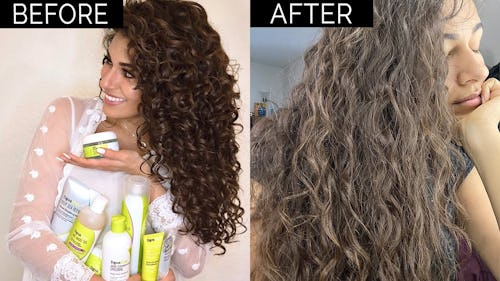
Ayesha Malik paced the hair care aisle at the Spokane, Wash. Walmart in frustration. It was 2013, and the then-23-year-old student couldn’t find the right products for her dark brown ringlets, which had wilted after years of dyeing and straightening.
Malik had always loathed her hair, but she finally wanted to care for her curls without changing their bouncy, spiraling texture.
“I spent an hour and a half in the hair care aisle, and this was before [stores] even had an ethnic section,” says Malik, who immigrated from Pakistan to Alaska when she was a child. “A Black woman with [kinky curls] saw me, and she’s like, ‘I love your hair.’ And I was like, ‘I love your hair!’ And she told me to try DevaCurl, and I tried it. And I fell in love.”
Malik used DevaCurl from 2013 to 2019. From 2017 to 2019, she promoted the company’s products as an influencer and posted hair care videos on her YouTube channel, which currently counts 248,000 followers. Malik’s love for DevaCurl was reciprocated: The multimillion-dollar company featured Malik and her gorgeous tresses on its website and social media as a testament to its unrivaled excellence in the curly hair world.
DevaCurl was not just seen as a product, but as a way of life. The company’s founder, Lorraine Massey, who stepped down in 2013, pioneered the Curly Girl Method, which encourages its followers to not shampoo their hair — as the harsh sulfates deprive curls of their natural oils and moisture — instead relying mostly on conditioners and gels for styling.
Shampoos sold by DevaCurl were generally ‘no-poo’ or ‘low-poo’, creating either a light lather or no lather at all, with the aim of retaining moisture that infuses curls with shape, form, and gravity-defying bounce. The company had a flagship salon in Soho, New York and its own stylist academy. The brand became so well-recognized that it even appeared in a 2019 episode of Broad City, in which Ilana is recruited as a model after someone from the company spots her sprightly bob.
And yet, in late 2019 and early 2020, many of the same people who had recommended DevaCurl with an almost cult-like fervor took it all back.
“Everyone in that Facebook group, their hair looks exactly like mine. Fried like we got hit by lightning, completely damaged.”
On the internet, one-time DevaCurl devotees alleged en masse that they had suffered chronic hair damage, including bald spots and excessive hair loss (or alopecia), scalp irritation, loosening of curl pattern, fading of shine and color, and dry, broken strands after using the company’s products. The more serious allegations included health issues like migraines. Facebook, Twitter, and Instagram erupted with photographs of brittle, dead hair and frenzied discussions on how to offset the damage.
Many had noticed long-term hair loss but attributed it to personal difficulties. Others had visited doctors in search of a diagnosis. These consumers now faced the possibility that DevaCurl could be the cause of their hair troubles. Stephanie Mero, a hairstylist, started a private Facebook group called “Hair Damage and Hair Loss from DevaCurl — You're not CRAZY or ALONE,” which currently has 58,000 members. On the page, former users of the brand, mostly women, offer advice and commiserate.
Malik publicly denounced the brand in a video that racked up 3.2 million views. Seeing other women’s stories online, she says, played a role in her decision. “Everyone in that Facebook group, their hair looks exactly like mine. Fried like we got hit by lightning, completely damaged,” Malik says. “If it wasn’t for that, I would have blamed [my damage] 100 percent on myself, and not on DevaCurl.”
DevaCurl faced a class-action lawsuit alleging that the company had been deceptive in the way it touted its products. A $5.2 million settlement received preliminary approval in July 2021 and was formally approved in January. While more than a year has passed since the allegations against the company were aired online, people who have only just discovered widespread criticism of the curly hair giant still periodically appear in the Facebook group, complaining that they, too, are experiencing all the symptoms of hair loss and scalp irritation shared by other members.
DevaCurl stands by the quality and safety of its products, and tests conducted by the company after the controversy established that they “are safe, do not cause hair breakage or hair loss, and are proven to be non-irritating.” The company’s advertising was not found to be false or misleading in the class-action settlement.
“DevaCurl products and ingredients have always met the strictest health and safety guidelines — and that will never change. We are excited to continue the work we started more than 25 years ago to continue to be a trusted partner in millions of curl journeys,” Kelly Heath, vice president of sales, trade marketing, and education at DevaCurl, tells Input via email.
The big chop
The devotion and trust DevaCurl inspired in many of its consumers, current and former, is deeply tied to the vulnerability that’s arisen from the lack of representation of curly-haired people in mainstream beauty spaces and mass media, and the aspirational standard of what beautiful hair should look like. Wearing hair naturally is a challenging task for people with curly, coiled, and/or kinky hair textures. Salons that specialize in curly hair are not ubiquitous, and they are usually expensive compared to regular hair salons, because styling curly hair requires more time, effort, and care.
Big, curly hair is often considered unruly and unprofessional, and while curls appear across all racial groups, natural hair is primarily associated with the Black community and other people of color — and comes with discriminatory stereotypes.
Growing up, I hated my hair, which was a monstrous mass of frizz on my head with flyaways sticking out in different directions. I only liked my hair when it was wet, because then I could pretend that it was straight. My mother, who had shining straight black hair as if out of a Sunsilk ad, was at a loss for what to do. Eventually, she gave up. I resigned myself to pulling my hair into a modest ponytail, where it would attract as little attention as possible. In my teen years, I permanently relaxed my hair twice, sucking out all the moisture from it and ruining its curl pattern.
I started wearing my hair naturally and investing in its health in my early twenties after I got a haircut at Ouidad, a curly hair salon in Manhattan. Almost a year later, I started using DevaCurl, which a friend had gifted to me and swore would change my life. Gradually the quality of my hair declined, and my natural curl pattern — somewhere between a wave and a ringlet — loosened. Dandruff attacked my scalp, and I scratched until it bled.


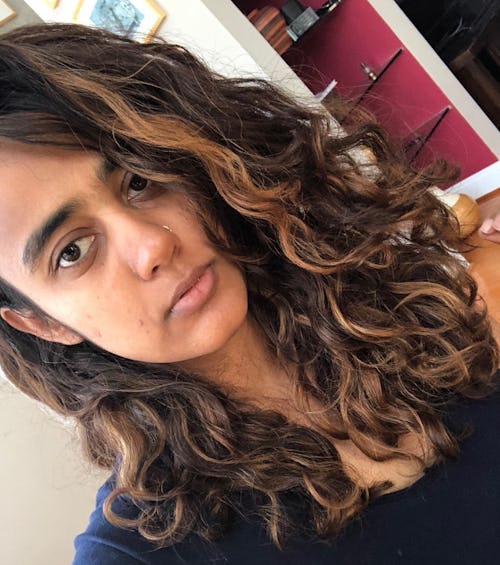
I blamed myself for not doing the Deva process correctly and made up other excuses: I hadn’t gotten a proper haircut; the humidity was damaging my hair; I was eating too much junk food. Then, when I saw the online uproar, I realized that maybe I wasn’t just having a very long series of bad hair days.
When I saw the online uproar, I realized that maybe I wasn’t just having a very long series of bad hair days.
I initially glimpsed the collective rage on Twitter, where people posted before and after pictures of using DevaCurl. Perfectly plump and luminous curls had wilted after using a product that was supposed to make them healthier, shinier and prettier. Sometimes, consumers exhibited the pictures in reverse — people who had used DevaCurl posted pictures of frizzy, limp, strands, which then blossomed into fuller waves and/or better-defined ringlets after they switched products.
I joined the Facebook group to understand what exactly had happened to other people in the curly-haired community, and to unlock the mystery of my own hair. In the group, I found Kai Lopes-Stovell, a 43-year-old hairstylist in Boston, who had been using DevaCurl since 2016 and attended the institute in New York in 2017; the former salon where she worked was certified by DevaCurl.
Lopes-Stovell had never faced much struggle with her hair until she started using DevaCurl. The health and beauty of her explosive ombre 3c curls often attracted enthusiastic clients and vitalized her business as a stylist. But with time, she noticed that her scalp was constantly dry, and her corkscrew curls flattened into thin, fried-looking wisps.
The damage
Lopes-Stovell (pictured) claims that repeated use of DevaCurl over the course of years led to her hair drying and curl pattern changing.
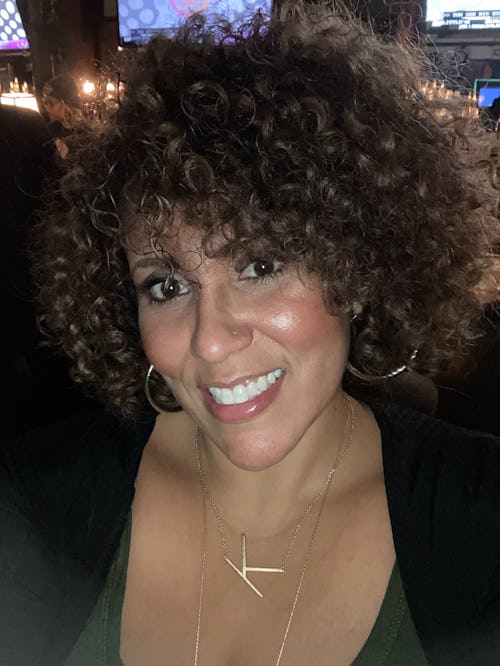
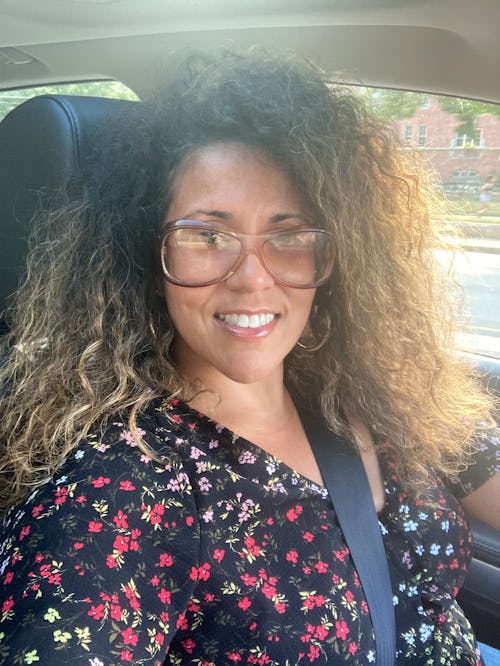
“I had a trust naturally in the product, so I didn’t attribute it to that at first at all. I thought that something was going on with me unrelated to the product. But eventually, my curl pattern began to severely change. I started noticing stray pieces because of the dryness of my scalp,” Lopes-Stovell says.
Lopes-Stovell did what many people in the group did: She chopped all of her hair off. The “big chop,” as it’s called, encourages new hair growth, and allows people with curls a fresh start after suffering the distress of losing their hair. For Lopes-Stovell, the big chop wasn’t easy, but she didn’t think she had better options. “I’ve never wanted to have short hair,” she says. “But I had to [cut it off] because I can’t even represent being a hairstylist, whose hair looks beautiful, with the hair that was left on my head. It was traumatic. I felt like I became my own client.”
Juliette Cabrera, 35, a math teacher in New Jersey, also cut her hair off after using DevaCurl for five years. “I was losing an extreme amount of hair when I was showering. And one day, my boyfriend’s like, ‘That doesn’t seem right.’ And as curly-haired people, we always lose hair, so we always figure, ‘Oh, this is normal,’” Cabrera says. “But then one day, just a chunk of hair came out as I was washing it off. And I sided with my boyfriend for the first time ever.”
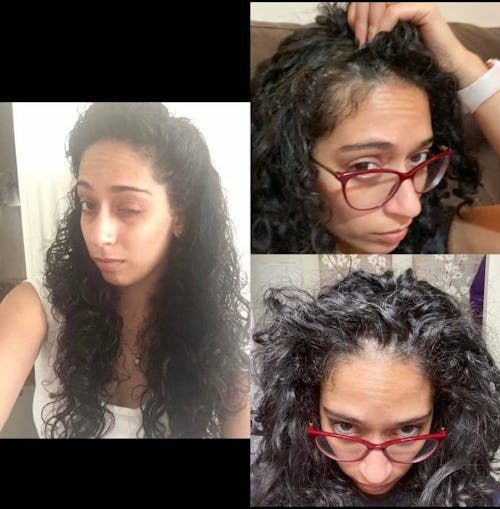
While Cabrera embarked on a new journey with her hair after the big chop, she still panics when her hair falls out and is careful about using new products. And like many others, Cabrera also had a deep trust in DevaCurl. She initially discovered the product at a salon, and then used it “on and off” until she could afford to buy it more regularly. (A standard 12-ounce bottle of DevaCurl shampoo or conditioner costs $26.) Using DevaCurl, Cabrera says, helped her take pride in her natural curls.
“I used to straighten my hair all the time because I just didn’t like how it looked. And once I found DevaCurl, I was actually, finally having good hair days. People used to stop me in the street and say, ‘Your hair looks so great. It looks so beautiful,’” she said. “The faith that I had in it was from my hair becoming more curly. I stopped straightening my hair. I started to gain confidence in myself, as somebody who grew up with unruly hair, but could be out there in the world with my [natural] hair.”
Not everyone who used DevaCurl suffered damage to their hair. Asia Jackson, a 27-year-old actress in Los Angeles, first discovered DevaCurl in high school. “It’s a brand that really accompanied me on my journey to loving my hair,” Jackson says. “It took me years to figure out the right DevaCurl product combination. Not all DevaCurl products are for all hair types. It's all about knowing what does or doesn't work for your hair, and making changes correspondingly.”
And yet, the scale of the alleged damage is staggering enough that the fundamental trust on which DevaCurl built its reputation has been compromised. “I understand that everyone who used it wasn’t affected the same, or even affected at all,” Lopes-Stovell says. “But too many were.”
The settlement gave consumers the option to submit a claim due in November 2021. A claim of significant injury after using DevaCurl, in which the claimant provides video documentation, photographs, witness statements, and medical records, can incur a compensation of thousands of dollars and a refund of the products. But the more common claim form, which asserts a personal injury and doesn’t provide substantial documentation, awards a one-time payment of up to $20, which is less than the cost of a standard bottle of DevaCurl.
“DevaCurl is not cheap,” Cabrera says. “And if you’re going to give people money, it shouldn’t be less than what your bottles cost.”
Not alone
DevaCurl is not the only beauty company to face a lawsuit for allegedly causing injuries to its consumers. A class-action lawsuit filed against Johnson & Johnson alleges that its ogX line, which uses natural extracts like coconut and argan oil in its products, and is also favored by people with curly or textured hair, has led to hair loss and scalp irritation. In 2012, Brazilian Blowout, a keratin treatment meant to transform frizzy hair into voluminous, lustrous strands, settled a class-action suit for $4.5 million. Brazilian Blowout emitted formaldehyde gas, a carcinogen that can cause cancer, and which is discouraged for use by the FDA, though not outright banned.
Toxic substances, mostly preservatives, pervade the beauty world, including cosmetics, body lotions, and skincare products.
Lily Tse founded the Think Dirty App in 2012 after her mother was diagnosed with breast cancer for the second time. The application helps users assess the potential toxicity of a beauty product by giving it a rating on a scale of one to 10 based on official toxicology reports and peer-reviewed research. “The reason why we rate some [products] eight and above is because they contain preservatives or fragrances. Products have to sit on the shelf at least six months to a year. So if you want a product to exist for a long time, you simply need preservatives,” Tse says. “And it’s very common for formaldehyde-releasing agents to exist in preservatives.”
Use of preservatives with formaldehyde-releasing agents on the scalp can lead to “burning, redness, and swelling,” says Vivian Wong, a dermatologist based in Florida. “The most common thing I hear from patients is that their hair breaks very easily, becomes coarse or loses luster,” she says. Continued exposure to products with these preservatives can lead to allergic contact dermatitis, a rash that develops slowly and can potentially spread across the body.
Amy Davis is a Dallas-based attorney litigating against DevaCurl in a separate lawsuit representing 115 clients, mostly women. Davis says that most of her clients experienced scalp injury and hair loss, and that for some, the alleged injuries are even more devastating. “The primary mechanism for personal injury of the product were formaldehyde releasers,” Davis says. “And we’ve known for some time now formaldehyde is an endocrine disruptor. It can affect your hormones and other chemicals in the body, and we’ve had at least one person who’s had issues with fertility as a result of using the product,” she says. DevaCurl denies using formaldehyde in its preservatives on its website.
“The way they helped, the advice and all they gave willingly, it was very helpful in the beginning where I felt like everything was a lie and falling apart.”
Today in the DevaCurl-focused Facebook group, women post success stories of hair growth after shaving or cutting their hair; others bond over healing their bald spots and share suggestions on how to recover from alopecia. Many still report suffering loss of hair and volume, and struggle to regain their old hair texture, even after ceasing to use DevaCurl products. The journey to emotional healing and hair restoration is long, but thanks to the community online, it doesn’t have to be in isolation.
“It was so heartbreaking to see how everybody else was suffering,” Cabrera says. “It was overwhelming, the amount of support when I first went on there. The way they helped, the advice, and all they gave willingly, it was very helpful in the beginning where I felt like everything was a lie and falling apart. And just knowing that I wasn’t alone, and that hopefully we were all going to get past it together.”
Consumers, influencers, hairstylists, and former DevaCurl devotees used the Facebook group to share stories, validate each other’s experiences, and identify the possibility that a problem could exist with the products they used. If it hadn’t been for the online bonding of people with curls on the Facebook group, I would have continued using the products, lost and aimless in my hair care routine, waiting for the renowned magic of the holy grail for curly-haired women to finally take hold.
I had only used DevaCurl for a few months, so the damage I experienced was thankfully not permanent or long-lasting. And yet, others who had believed in the products and used them for years were not as lucky.
“I spent my entire life hating my curly hair, and so once it started flourishing, it became a huge part of my identity, and everything else flourished because I could focus on other aspects of my life,” Ayesha Malik said. “Now that my hair is absolutely destroyed, a part of me died, and I went through depression because of it.” Malik is unsure whether she will ever recover her chestnut Botticelli curls, which once fell effortlessly down her back, and she believes DevaCurl is responsible for the seemingly irreversible lifelessness of her strands. “They don’t deserve a second chance,” she said. “They deserve to stop existing.”







